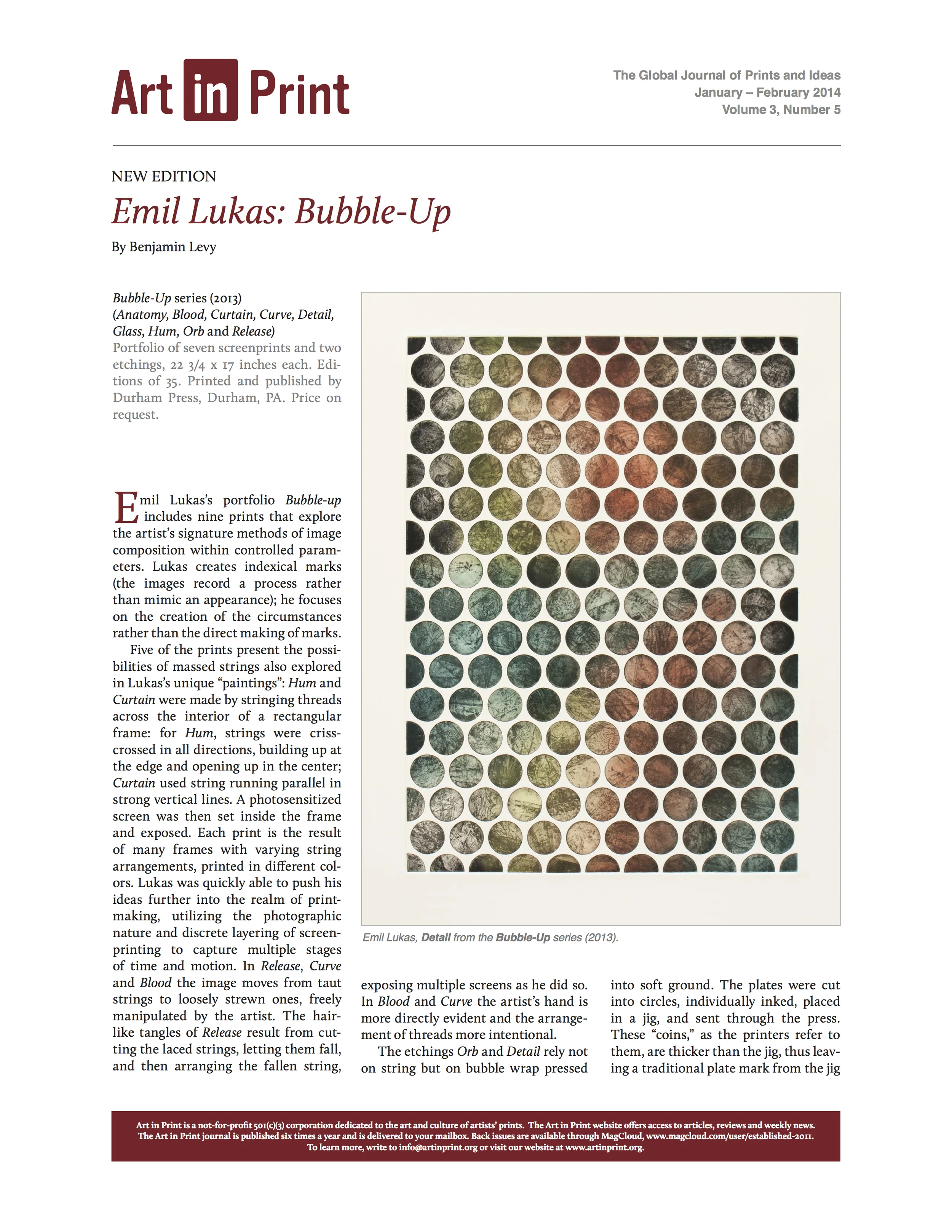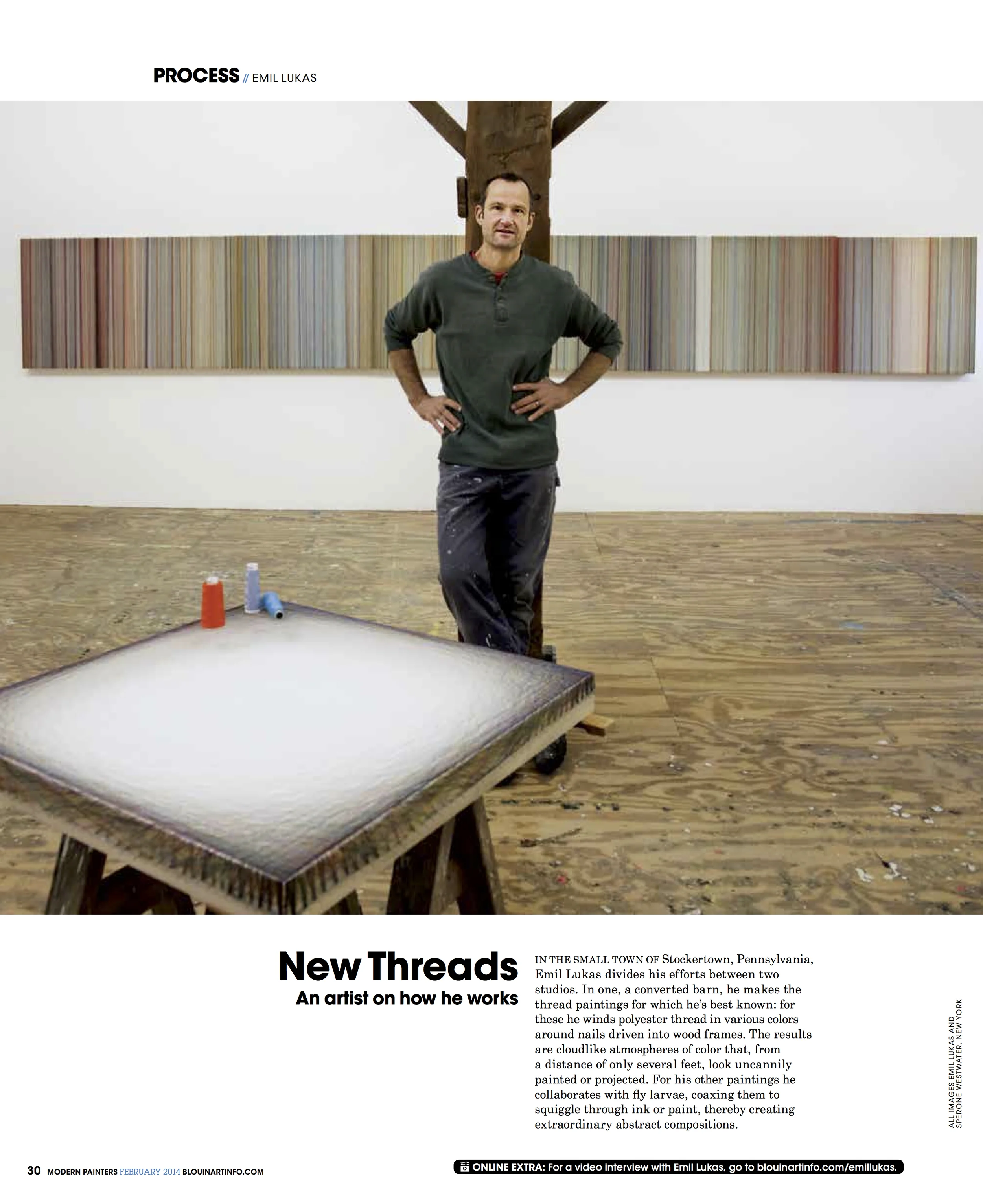Artinfo.com – “Emil Lukas, Weaving Art With Nature”
The article & video can be found here: BLOUIN ART INFO
Who might have thought spools of thread in every Pantone shade and trails of ink-covered crawling larvae would be the foundations of a painters work? Those are the media at the core of new inspirational body of work from Emil Lukas. For his latest eponymous exhibition, the Pittsburgh-born artist brings his layered pieces of thread and larvae paintings to Sperone Westwater Gallery in New York City.
Lukas lives and works in Stockertown, Pennsylvania, where he converted a 19th-century barn into a studio where he weaves his distinctive thread paintings.
He creates his stratified pieces in a silent dance: Lukas loops a line of thread on nails affixed on the sides of a shallow box, stretches it across the face, and waltzes to the opposite border where he takes a moment to observe the composition before locking it down.
“It’s a very meditative state,” said Lukas. “The relationship is one with light, color, and the relative color that’s going on with the painting.”
He continues the technique with other strands of thread in multiple shades and he calls the result a “painting”. They are dense on the edges and seem to emit an ethereal glow from a distance. However, the individual lengths of raw material and color reveal themselves as one draws closer to to the work.
While Lukas’ thread paintings suspend in a box of optical-illusion color, his larvae paintings are grounded in complex layers of monotone.
A few hundred yards away from Lukas’ studio was an old Massey Fergusen Tractor dealership factory, which he bought a year ago and turned it into his experimental space for his larvae works.
In the summer, Lukas breeds fly larvae eggs in the space and begins working on multiple paintings at one time. He introduces mature larvae onto a primed canvas and deposits ink next to them. He maneuvers their movement by casting light and shadows while they crawl, dragging the ink across the surface, creating dynamic squiggly lines. He applies a milky wash over the larvae-drawn canvas and repeats the process.
“One of the thoughts is to bring something from the outside, work with it for a short period of time, and then return it.” said Lukas. “With that, [I] capture some potential from that experience.”
Lukas doesn’t keep count of how many larvae or layers he goes through to finish the paintings. But rather, he goes for a “look” or pictorial atmosphere he wants to achieve, often based on the title or relationship it has with paintings next to it.
“We are an accumulation of our experiences,” said Lukas. “It’s a basic function in life and that function has found its way into my work for the last 25 years.”
The exhibition at Sperone Westwater runs through February 22.
by Dion Tan, Eric Gonon 10/01/14 7:02 AM EST
Arteidolia - "Curating my Refrigerator"
Full article found here: ARTEIDOLIA
I’ve begun to curate my refrigerator, possibly as a result of being trapped indoors during the Catskills winter. My first “show” consists of a large postcard (7″ x 10″) from the current exhibition at the Sperone Westwater Gallery, on the Bowery in New York. It’s a detail of “Red Gas” by Emil Lukas, which at first seems to be an angular abstract painting in the style of the 1950s — it could be the cover of a jazz album — but when you look closer, is thousands of strands of thread, attached to pins on the edges of the “painting.” (None of this is clear in the postcard, which is being held by a little stuffed animal: a spotted dog with magnetized paws. Nearby is a monkey holding our shopping list, which currently consists of:
pintos
Ream
matches
oranges
veg.
“Ream” means a ream of paper. “Veg.” is short for “vegetables.”) At Sperone Westwater, Lukas’ work was impressive, accomplished, but rather empty. On my refrigerator, the piece is consoling. Maybe it’s the miles of white snow around us, but red thread cradling a bluish sphere seems mystically meaningful. Within each of us is a delicate sphere we must protect.
Article ©2014 ARTEIDOLIA





